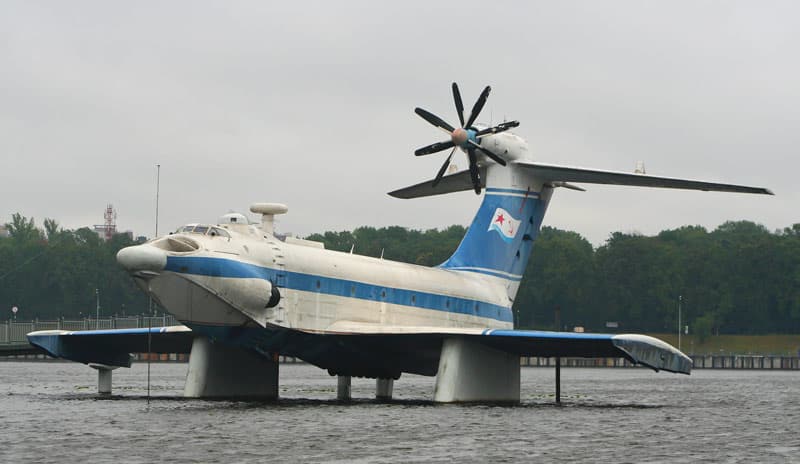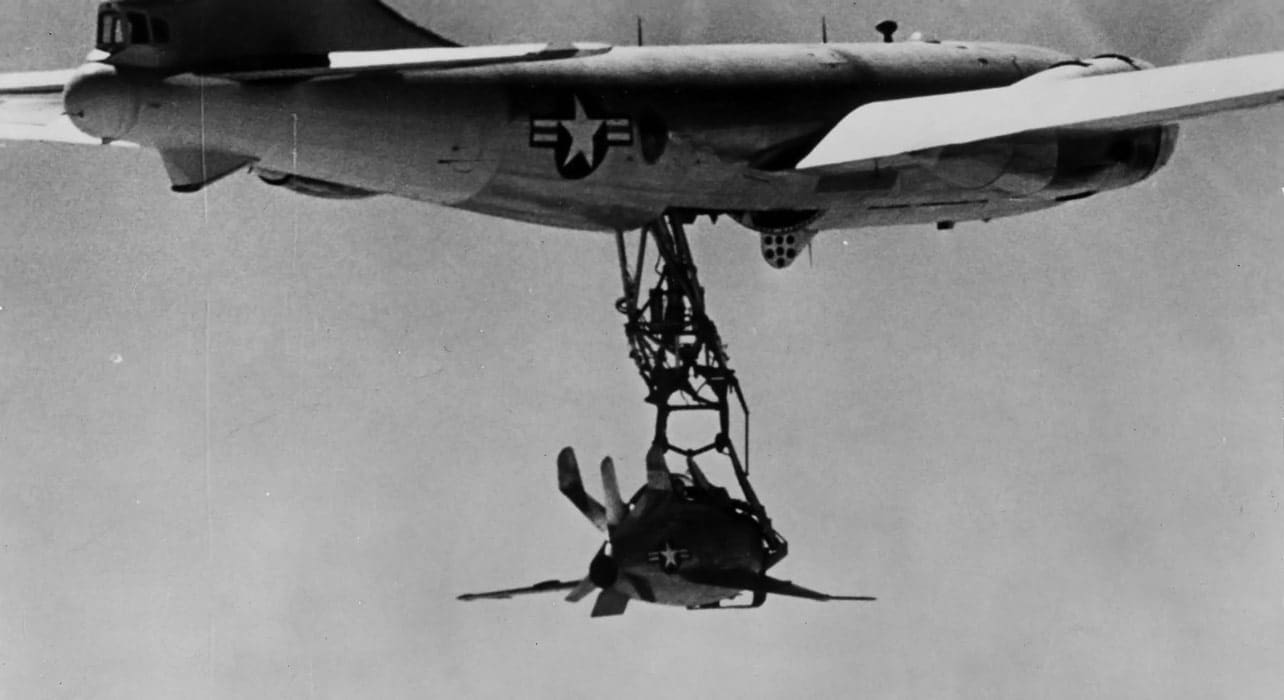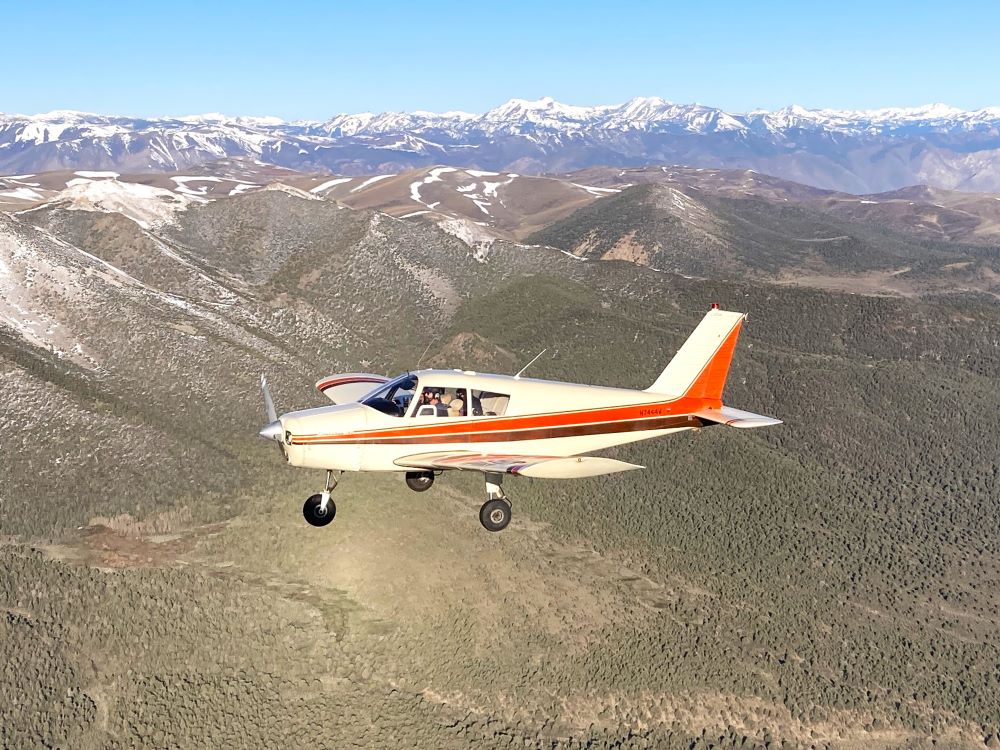What the heck is an Ekranoplan? Or the A-90 Orlyonok?
Ekranoplans are curious craft, flying a few feet off of the ocean at high speeds completely intentionally. Also known as ground effect vehicles, Ekranoplans are aircraft which “fly” via the aerodynamic interaction between the craft’s wing and the water beneath. In fact, some Ekranoplans aren’t aircraft at all under some definitions, as many aren’t capable of generating enough lift to gain altitude beyond a very low ceiling. The A-90 Orlyonok doesn’t suffer from these limitations, however.
Without question, the A-90 was a product of the Cold War’s obsession with military technology. Capable of reaching an altitude almost 10,000 feet while maintaining 400 km/h, the A-90 is a plainly weird vehicle that came about in the Soviet era. The first bizarre aspect of the A-90 is its tail, which sports its primary turboprop smack in the center. The lower wings of the A-90 are permanently tilted slightly upward, which gives the plane an impression of struggling. To the contrary, the A-90 Orlyonok handles one situation with unparalleled grace: flying close to the ground at very high speed.
The Ground Effect
Pilots will be familiar with the ground effect, which allows for better speed and lift when flying very close to the ground. For most pilots, the only in-flight actions that involve the ground effect are landing, taking off, or having a really bad day. All Ekranoplans utilize the ground effect to gain lift by design, and the A-90 is no exception.
The ground effect was discovered informally by the pilots of the 1920s and later explored more fully by a few core researchers, which we’ll get to later. The primary reason the ground effect works is that flying close to the ground prevents vortices from forming at the wingtips of the plane. As the vortices begin to form, their tail ends crash into the ground, defusing their force and preventing the full vortex from occurring. A wingtip without a vortex is a wingtip that is producing less drag, allowing vehicles which use the ground effect to go much faster than they would if they were slightly higher. To exploit the advantages of the ground effect, the aircraft must be within one wingspan’s distance from the ground. This also means that the closer the plane is to the ground, the less the wingtip vortices can form, and the faster you can go.

The disadvantages of using the ground effect are that you’re extremely close to the ground, moving extremely quickly, with a limited ability to bank in either direction. This explains why ekranoplans like the A-90 Orlyonok are used almost exclusively over water; any obstruction whatsoever is very difficult to avoid when flying close to the ground, and ekranoplans typically fly very quickly. Gaining altitude is the only recourse for an ekranoplan that suddenly encounters an obstacle like a boat. Attempting to bank too hard will cause the aircraft’s wings to graze the water’s surface, likely bringing the plane to a violent spinning halt.
The A-90 was also capable of flying over land using the ground effect, though it would be significantly more dangerous for the reasons above. Instead of this, the A-90 could also generate enough lift to fly using normal aerodynamic principles, so it wasn’t necessarily constrained to very low altitudes. True to its original conception as a military vehicle, the A-90 is equipped with massive wheels which it can use to waddle ashore after landing in shallow waters to decelerate at high speed. If caught unloading cargo, the A-90’s entire cockpit, and nose can be seen tilted upward on their hinge to reveal an expansive windowless cargo space, capable of transporting an entire armored vehicle as well as an entire company of troops. The A-90’s cargo capacity was measured at 61,000 pounds—quite impressive for a high-efficiency seaplane.
Parasite Fighters: 40 Years Were Spent Trying To Make Them Work
 During the early days of military aviation, the effective range of most aircraft was quite limited, meaning that aircraft with ground attack or bombing missions were frequently without fighter escort and thus vulnerable to aerial attack. In this same time period, aerostats were in common use for military purposes and thought to be especially vulnerable to enemy fighters. From this threat arose the concept of parasite fighters, small fighters [Click to read more…]
During the early days of military aviation, the effective range of most aircraft was quite limited, meaning that aircraft with ground attack or bombing missions were frequently without fighter escort and thus vulnerable to aerial attack. In this same time period, aerostats were in common use for military purposes and thought to be especially vulnerable to enemy fighters. From this threat arose the concept of parasite fighters, small fighters [Click to read more…]
Alexeyev’s Ekranoplan
The A-90 was originally designed as a military vehicle for the Soviet navy to transport their marines and supplies across the Caspian Sea and the Black Sea regions. This is a bit misleading, however: ekranoplans like the A-90 Orlyonok only flew whatsoever as a result of longstanding advocacy by their inventor, the legendary aerodynamic engineer Rostislav Alexeyev. Alexeyev was originally a shipbuilder and discovered the ground effect during his experimentation with high-speed ship designs.
Interested in his initial discovery of the ground effect, Alexeyev was poached by the Soviet navy. Alexeyev would be a continuous advocate for the use of ekranoplans, and succeeded in negotiating the adoption of one of his favored designs—the A-90. The A-90 was the apex of ekranoplan design, and incorporated many features that former prototypes had lacked. Unlike many other experimental plane concepts, ekranoplans claimed no fatalities during the numerous mishaps during their testing and development due to its requirement of being close to the water.
The Soviet navy thought the A-90 could be stealthier than a cargo plane and faster than a boat. In traditional Soviet fashion, the A-90s the Navy received were retrofitted with machine guns, though the craft weren’t rated for combat use. The A-90 entered service in 1979 in small numbers, most of which were lost in accidents. Only five A-90s were ever built, though hundreds were ordered. The A-90’s accidents ended up costing Alexeyev his career, and he retired early. After Alexeyev’s retirement, the Soviet navy canceled further ekranoplan research, along with their remaining plane orders.
Ekranoplans are still skimming
The closure of the Soviet ekranoplan program wasn’t the end of ground effect vehicles, though. The A-90 Orlyonok served until the 1990s, and its example inspired German, American, and Iranian designs to continue being tested and deployed. The A-90 may serve as a blueprint for civilian ekranoplan use within modern Russia, filling the niche of transportation across Siberia as well as the Arctic.
A-90 Orlyonok Specs
General characteristics
- Crew: 6
- Capacity: 150 personnel
- Payload: 28,000 kg (61,730 lb)
- Length: 58.1 m (190 ft 7 in)
- Wingspan: 31.5 m (103 ft 4 in)
- Height: 16.3 m (53 ft 5 in)
- Wing area: 304 m² (3,272 ft²)
- Max. takeoff weight: 140,000 kg (308,647 lb)
- Powerplant:
- 2 × Kuznetsov NK-8-4K turbofan, 103 kN (23,155 lbf) each
- 1 × Kuznetsov NK-12MK turboprop, 11,033 kW (NK-12MV) (14,795 ehp)
Performance
- Cruise speed: 400 km/h (248.5 mph)
- Range: 1,500 km (932 mi)
- Service ceiling: 3,000 m (9,842 ft)
Armament
- Guns: 2 x 12.7 mm machine guns in twin dorsal turret
Featured Image: courtesy of Alex Beltyukov, CC BY-SA 3.0


